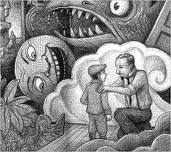 “He wished that he was with his mom in her library, where everything was safe and numbered and organized by the Dewey decimal system. Ben wished the world was organized by the Dewey decimal system. That way you’d be able to find whatever you were looking for, like the meaning of your dream, or your dad.”
“He wished that he was with his mom in her library, where everything was safe and numbered and organized by the Dewey decimal system. Ben wished the world was organized by the Dewey decimal system. That way you’d be able to find whatever you were looking for, like the meaning of your dream, or your dad.”
Ben’s mother worked as the librarian in their small town, until she died in an accident, leaving Ben alone and lost. He never knew his dad. Now he lives with his aunt and uncle, who are kind, but after losing his mom, he can’t help but wonder about his father: where is he? Who is he? During a thunderstorm, he discovers a mysterious message that he thinks could be from his father, and he is determined to get to the bottom of things, even if it means getting to New York City on his own.
Half a century earlier, Rose is being pushed to learn to lipread. She rebels, cutting up her lipreading primer and turning it into a diorama of New York. She keeps a scrapbook of her favorite movie star, and goes to all her movies. Even though she can’t hear, Rose can still go to silent movies, and read the dialogue, like everyone else. When she sees a newspaper headline that says Lillian Mayhew, her heroine, will be in New York soon, Rose sets out for the big city.
Rose’s part of the book is told entirely with Selznick’s intricate, enchanting pencil sketches, while Ben’s story is told with words. The effect, much like The Invention of Hugo Cabret, is rich; this, like its predecessor, is a book to be treasured. Indeed, Wonderstruck shares several similarities with Selznick’s previous book: orphan protagonists, museums, secret messages, and adventures that take place in very important cities. I especially loved that the two books were so similar, because I felt bereft after I finished The Invention of Hugo Cabret, as though there was unlikely to ever be another book that made me feel the same way. I shouldn’t have worried, though: with the release of Scorsese’s magical film rendition of Hugo, followed by Wonderstruck, the stories aren’t over.
is told with words. The effect, much like The Invention of Hugo Cabret, is rich; this, like its predecessor, is a book to be treasured. Indeed, Wonderstruck shares several similarities with Selznick’s previous book: orphan protagonists, museums, secret messages, and adventures that take place in very important cities. I especially loved that the two books were so similar, because I felt bereft after I finished The Invention of Hugo Cabret, as though there was unlikely to ever be another book that made me feel the same way. I shouldn’t have worried, though: with the release of Scorsese’s magical film rendition of Hugo, followed by Wonderstruck, the stories aren’t over.
 My advice? This is a book for sharing. Read it to your classroom after recess: the mystery will keep the students engaged, while the ethereal illustrations will inspire even the most timid budding artist. Read it to your children, to anyone you love who cares about Deaf culture, dioramas, paper art, the American Museum of Natural History, libraries, adventures, thunderstorms, or New York. Read it with hot chocolate and a mind ready to marvel. Selznick’s world is meaning-rich and stocked with secrets. He is clearly an author that has not forgotten what it like to dream. Let’s all hope he has another book dreamed up for us, and soon.
My advice? This is a book for sharing. Read it to your classroom after recess: the mystery will keep the students engaged, while the ethereal illustrations will inspire even the most timid budding artist. Read it to your children, to anyone you love who cares about Deaf culture, dioramas, paper art, the American Museum of Natural History, libraries, adventures, thunderstorms, or New York. Read it with hot chocolate and a mind ready to marvel. Selznick’s world is meaning-rich and stocked with secrets. He is clearly an author that has not forgotten what it like to dream. Let’s all hope he has another book dreamed up for us, and soon.
Happy Reading!
Wonderstruck website: http://www.wonderstruckthebook.com
Selznick, Brian. Wonderstruck. Scholastic Press: New York, 2011. 635 pp. (I promise, it doesn’t feel like it at all; you are going to wish it would last forever.) Ages 10 and up.
If you liked this book, try The Invention of Hugo Cabret or the shorter graphic novel, Shaun Tan’s The Arrival.



